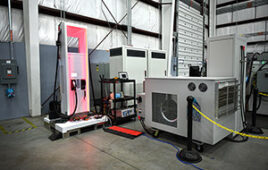
Zichun Zhong and Jing Hua, Department of Computer Science, College of Engineering, Wayne State University. (Credit: Julie O’Connor, Wayne State University)
A research team from Wayne State University’s College of Engineering received a nearly $500,000, three-year grant from the National Science Foundation to develop a rigorous computing system that will make it easier to understand and analyze the internal workings of the human body.
The project, “CHS: Small: High-Dimensional Euclidean Embedding for 4D Volumetric Shape with Multi-Tensor Fields,” centers on technical frameworks and theories that will make it possible to effectively and efficiently represent and process 4D Riemannian volumetric shapes from a new perspective. There is a pressing need to model and analyze these objects, which are captured by various imaging devices.
“In cardiology, for example, high-fidelity modeling and processing of 4D deformable volumes of cardiac organs and tissues with complex properties, shape geometry, motion and deformation at different phases of the cardiac cycle in real-time becomes important for building an effective and unified tool for doctors,” said Zichun Zhong, Ph.D., principal investigator of the research project and assistant professor of computer science at Wayne State. “This can assist physicians with accurately visualizing, tracking and diagnosing patient conditions.”
According to Zhong, the project will center around a high-d Euclidean geometric embedding framework that integrates Riemannian metric, tensor field and Nash embedding theory, making it possible to effectively and efficiently represent and process the 4D Riemannian volumetric shapes from a new perspective. Through this complicated process of validating the framework using 4D shape-tensor reconstruction and analysis, it will be possible to offer medical imaging and biomedicine communities an accurate, robust and rigorous approach for geometric reasoning and quantitative assessment of multiheterogenous features and properties across different objects.




